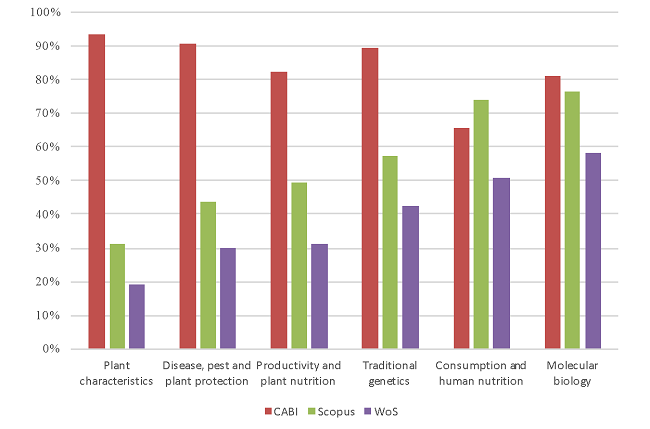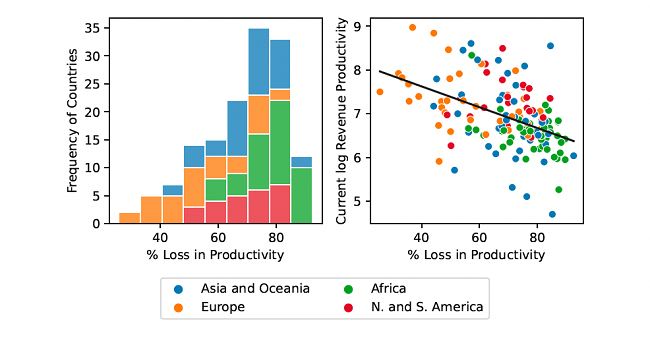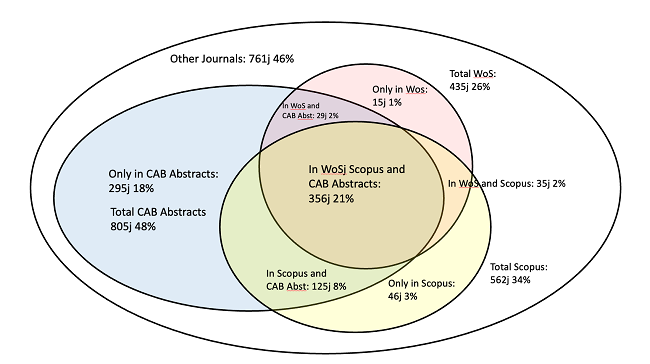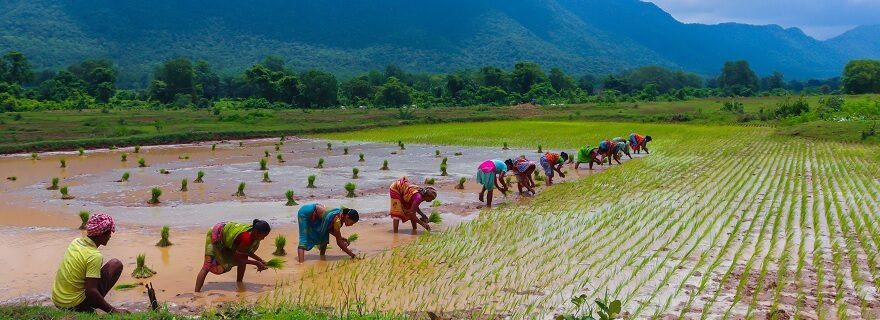Why coverage matters: Invisibility of agricultural research from the Global South may be an obstacle to development
To support development and sustainability in the Global South, contextual and locally appropriate knowledge on agriculture needs to be visible and accessible. Improving coverage in global open scholarly infrastructures can play a crucial role in increasing visibility.
How agriculture benefits from research through extension and engagement
Different sectors benefit from science in different ways. In the case of agriculture, innovations based on science often originate from providers of farmers, for example in the form of seeds or machinery. However, the diffusion or uptake of innovations is difficult, in particular for small farmers. For this reason, the dissemination of agricultural research through initiatives like ‘extension’ programs has long been recognized as essential for development.
These extension activities to reach out to small farmers are particularly important in relation to improving livelihoods. In 2020, 720-811 million were suffering from hunger worldwide, of which 50% were estimated to be small farmers. This means that improving food security requires forms of research transfer and local and indigenous knowledge integration that reach out to small farmers, who constitute a particularly vulnerable group.
Public organisations working on agriculture have long been aware of the centrality of ‘extension’ for improving rural livelihoods. The reason is that agriculture depends heavily on contexts, and agricultural contexts may change dramatically across short geographical distances due to variations in climate and soils. The notion of ‘extension’ research gradually shifted from top-down, unidirectional teaching from researchers to farmers, toward more mutual learning and co-operation between researchers and farmers, so that science can respond to these local needs and contexts. Through participatory and learning approaches can technical and local knowledge be combined in order to achieve appropriate technologies.
The lower visibility of engaged scholarship in agriculture may lead to use of inappropriate technology
However, research that is more engaged with users and more orientated towards application tends to be associated with lower academic visibility, because its publications are often not included in the mainstream bibliographic databases.
Various studies have shown that coverage of journals of agricultural sciences in mainstream databases is lower than in the natural sciences, but well above the social sciences and the humanities. Yet the situation is much worse in terms of the coverage of the Global South in the mainstream databases. For example, studies by Subbiah Arunachalam in 2001 showed that of the 10,000 publications by Indian researchers in agricultural research, 78% were in Indian journals and 77% were not indexed by Web of Science. Other studies have highlighted that crops relevant in the Global South also have a much lower coverage in Web of Science (WoS), for example the crop pearl millet.
A study on rice research found that coverage of publications in mainstream databases was 2 to 3-fold higher for the Global North. Similarly, the coverage of topics relevant to the Global North in WoS and Scopus was 2-3-fold higher than the topics more relevant in the Global South – as illustrated in Figure 1 for the case of rice research.
Given that the mission of agricultural research institutes and councils is to increase food security, reduce poverty and improve natural ecosystems, knowledge communicated through a plurality of channels should be valued beyond mainstream international journals. This would include, for example, publication formats such as those collected by FAO in its AGRIS database (based on national collection and analysis centres), which include coverage of more diverse document types (reports, policy briefs, etc.) in comparison to citation index databases such as WoS or to abstracting and indexing databases such as CAB Abstracts.
This lack of visibility has at least two downsides. First, universities or research institutes conducting extension programmes or engaged agricultural research have often come to be perceived as not doing prestigious science – as excellence has increasingly been defined according to publications in prestigious journals. As a result, researchers may feel motivated to study topics valued by ‘top’ journals, which are mostly focused on topics in the Global North.

Second, without being indexed in databases and without good Academic Search Engine Optimization for Open Access content, valuable contextual knowledge is harder to discover, making it challenging to retrieve or access it. In consequence, technical experts in agriculture in the Global South are more likely to apply technologies which are inappropriate in their countries. For instance, the crop varieties that are available in WoS may not correspond to relevant varieties for a tropical context, and information about the crops may be appropriate for Europe but inappropriate in Brazil or India. Including more local agricultural journals in bibliographic databases could help promote local agricultural solutions, as researchers and practitioners would have access to a wider range of information and perspectives.
A recent study shows that countries in Africa and Asia suffer a much higher loss of productivity in agriculture than countries in Europe and the Americas as a consequence of the use of inappropriate technologies, where the degree of inappropriateness is estimated as the mismatch in the presence of crop-specific pests and pathogens (see Figure 2). This inappropriate use of agricultural technologies is partly due to the lower amount of research in topics and areas of interest of the Global South, but also partly due to the challenges in locating and accessing contextualised knowledge which already exists but is published in local venues (journals, reports, policy documents, etc.).

Towards broader coverage of agriculture in bibliographic databases
A new publication by the Public Knowledge Project interestingly challenges the perception, created by the conventional use of mainstream databases, that research is extremely concentrated in journals and publications of the Global North. Analysing 25,671 journals with 5.8 million documents of the platform Open Journal System (OJS), they found that 80% of the publications originated in the Global South, that 85% are in diamond Open Access (no fee for authors nor readers) and almost half of them have more than one language.
The success of the OJS infrastructure in making possible access and visibility of knowledge from the Global South suggests that it is high time for the development of more comprehensive databases. This has been a concern in medical research and social science and humanities (SSH), leading to the development of regional specialised databases such as Scielo (more on health) and Redalyc (more on SSH). In recent years we have also witnessed the development of more comprehensive databases like Open Alex, Dimensions or Lens.
We have conducted a small study using the MIAR portal of the ‘Information Matrix for the Analysis of Journals’ of the University of Barcelona in order to make a rough estimate of the journal coverage of various databases (see detailed methodology and journal data). As shown in Figure 3, from a sample of 1662 journals from any country with ISSN related to agriculture, we found that CAB Abstracts had the highest coverage with 805 (48%) journals, 562 (34%) of Scopus, 435 (26%) of WoS and 550 (33%) of Veterinary Sciences. In terms of regional coverage, CAB Abstracts and Veterinary Sciences have a better and broader coverage in the Global South in relative terms.

These results have to be contrasted with new databases such as Dimensions and Open Alex that index papers rather than journals. Here we have made some estimations for Dimensions, which showed a coverage of about 1160 (70%) of journals. The coverage was high also in the Global South, with 46 (41%) of African journals, against a 28 (25%) in CAB Abstracts. Only for a few countries, including Iran, Germany, Romania or Cuba, was Dimensions coverage lower than CAB Abstracts.
The downside of these new, more comprehensive databases (alongside with the Google Scholar Coverage) is the lack of inquiry of the publishing practices of journals. We found that some of the journals included in the larger databases, but not present in the more traditional databases such as CAB Abstracts, have a higher incidence of problematic or questionable editorial and review practices (here the term ‘predatory’ is unhelpful).
Another bibliographic coverage is possible, and necessary
In conclusion, another bibliographic world is possible where knowledge is more diverse and accessible – and this is important for agricultural research to be more visible and accessible in and from the Global South. Infrastructures towards this transformation have to be developed to enhance interoperability and cooperation. This is the case, for example, of the analysis centres that feed the FAO's AGRIS information system, including grey literature. While currently no single commercial bibliographic database has a good coverage of agriculture, a new generation of databases in conjunction with metadata aggregators from open access repositories may help fill this gap. This increase in diversity of journals comes at the cost of having a larger greyscale of rigour in journal editorial practices. This challenge could be overcome with catalogues of editorial practices such as DOAJ or Latindex and platforms such as MIAR.
It is about time to create more comprehensive open infrastructures to provide visibility and accessibility of agricultural knowledge relevant to many more contexts, particularly in the Global South, so that knowledge of appropriate technologies can foster human development across all the world.
Acknowledgement: We thank Subbiah Arunachalam, Tommaso Ciarli and Diego Chavarro for helpful discussions.
Header image: Jagamohan Senapati on Unsplash






0 Comments
Add a comment